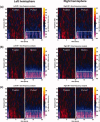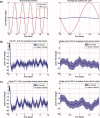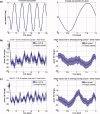Cortical oscillatory changes in human middle temporal cortex underlying smooth pursuit eye movements
- PMID: 22110021
- PMCID: PMC6869956
- DOI: 10.1002/hbm.21478
Cortical oscillatory changes in human middle temporal cortex underlying smooth pursuit eye movements
Abstract
Extra-striate regions are thought to receive non-retinal signals from the pursuit system to maintain perceptual stability during eye movements. Here, we used magnetoencephalography (MEG) to study changes in oscillatory power related to smooth pursuit in extra-striate visual areas under three conditions: 'pursuit' of a small target, 'retinal motion' of a large background and 'pursuit + retinal motion' combined. All stimuli moved sinusoidally. MEG source reconstruction was performed using synthetic aperture magnetometry. Broadband alpha-beta suppression (5-25 Hz) was observed over bilateral extra-striate cortex (consistent with middle temporal cortex (MT+)) during all conditions. A functional magnetic resonance imaging study using the same experimental protocols confirmed an MT+ localisation of this extra-striate response. The alpha-beta envelope power in the 'pursuit' condition showed a hemifield-dependent eye-position signal, such that the global minimum in the alpha-beta suppression recorded in extra-striate cortex was greatest when the eyes were at maximum contralateral eccentricity. The 'retinal motion' condition produced sustained alpha-beta power decreases for the duration of stimulus motion, while the 'pursuit + retinal motion' condition revealed a double-dip 'W' shaped alpha-beta envelope profile with the peak suppression contiguous with eye position when at opposing maximum eccentricity. These results suggest that MT+ receives retinal as well as extra-retinal signals from the pursuit system as part of the process that enables the visual system to compensate for retinal motion during eye movement. We speculate that the suppression of the alpha-beta rhythm reflects either the integration of an eye position-dependent signal or one that lags the peak velocity of the sinusoidally moving target.
Copyright © 2011 Wiley Periodicals, Inc.
Figures








References
-
- Baillet S, Mosher JC, Leahy RM ( 2001): Electromagnetic brain mapping. IEEE Signal Process Mag 18: 14–30.
-
- Brookes MJ, Gibson AM, Hall SD, Furlong PL, Barnes GR, Hillebrand A, Singh KD, Holliday IE, Francis ST, Morris PG ( 2005): GLM‐beamformer method demonstrates stationary field, alpha ERD and gamma ERS co‐localisation with fMRI BOLD response in visual cortex. Neuroimage 26: 302–308. - PubMed
MeSH terms
Substances
LinkOut - more resources
Full Text Sources

